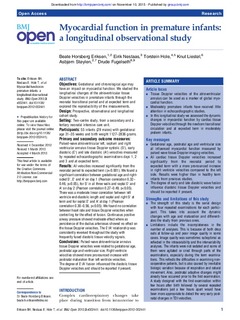| dc.contributor.author | Eriksen, Beate Horsberg | |
| dc.contributor.author | Nestaas, Eirik | |
| dc.contributor.author | Hole, Torstein | |
| dc.contributor.author | Liestøl, Knut | |
| dc.contributor.author | Støylen, Asbjørn | |
| dc.contributor.author | Fugelseth, Drude | |
| dc.date.accessioned | 2015-11-10T11:33:48Z | |
| dc.date.accessioned | 2015-11-23T11:41:01Z | |
| dc.date.available | 2015-11-10T11:33:48Z | |
| dc.date.available | 2015-11-23T11:41:01Z | |
| dc.date.issued | 2013 | |
| dc.identifier.citation | BMJ Open 2013, 3(3) | nb_NO |
| dc.identifier.issn | 2044-6055 | |
| dc.identifier.uri | http://hdl.handle.net/11250/2365217 | |
| dc.description.abstract | Objectives: Gestational and chronological age may have an impact on myocardial function. We studied the longitudinal changes of the atrioventricular tissue Doppler velocities in premature infants through the neonatal transitional period and at expected term and explored the reproducibility of the measurements.
Design: Prospective, observational and longitudinal cohort study.
Setting: Two-centre study, from a secondary and a tertiary neonatal intensive care unit.
Participants: 55 infants (29 males) with gestational age 31–35 weeks and birth weight 1127–2836 grams.
Primary and secondary outcome measures: Pulsed-wave atrioventricular left, septum and right ventricular annulus tissue Doppler systolic (S′), early diastolic (E′) and late diastolic (A′) velocities measured by repeated echocardiographic examinations days 1, 2 and 3 and at expected term.
Results: All velocities increased significantly from the neonatal period to expected term (p<0.001). We found a significant correlation between gestational age and right-sided S′, E′ and A′ on day 1 (Pearson correlation 0.32–0.46, p<0.05), for S′ in all three walls and septal E′ and A′ on day 2 (Pearson correlation 0.27–0.49, p<0.05). There was a moderate linear correlation between left ventricle end-diastolic length and septal and right S′ at term and for septal E′ and A′ at day 1 (Pearson correlation 0.30–0.56, p<0.05). We found no correlation between heart rate and tissue Doppler velocities when controlling for the effect of fusion. Continuous positive airway pressure showed moderate effect where as persistence of the ductus arteriosus showed no effect on the tissue Doppler velocities. The E′/A′ relationship was consistently reversed throughout the study with frequently fused diastolic tissue velocity signals.
Conclusions: Pulsed-wave atrioventricular annulus tissue Doppler velocities were related to gestational age, postnatal age and ventricular size. Right ventricle velocities showed more pronounced increase with postnatal maturation than left ventricle velocities. The degree of E′/A′ fusion influenced the diastolic tissue Doppler velocities and should be reported if present. | nb_NO |
| dc.language.iso | eng | nb_NO |
| dc.publisher | BMJ Publishing Group | nb_NO |
| dc.title | Myocardial function in premature infants: a longitudinal observational study | nb_NO |
| dc.type | Journal article | nb_NO |
| dc.type | Peer reviewed | en_GB |
| dc.date.updated | 2015-11-10T11:33:47Z | |
| dc.source.volume | 3 | nb_NO |
| dc.source.journal | BMJ Open | nb_NO |
| dc.source.issue | 3 | nb_NO |
| dc.identifier.doi | 10.1136/bmjopen-2012-002441 | |
| dc.identifier.cristin | 1087245 | |
| dc.description.localcode | This is an open-access article distributed under the terms of the Creative Commons Attribution Non-commercial License, which permits use, distribution, and reproduction in any medium, provided the original work is properly cited, the use is non commercial and is otherwise in compliance with the license. See: http://creativecommons.org/licenses/by-nc/3.0/ and http://creativecommons.org/licenses/by-nc/3.0/legalcode | nb_NO |
